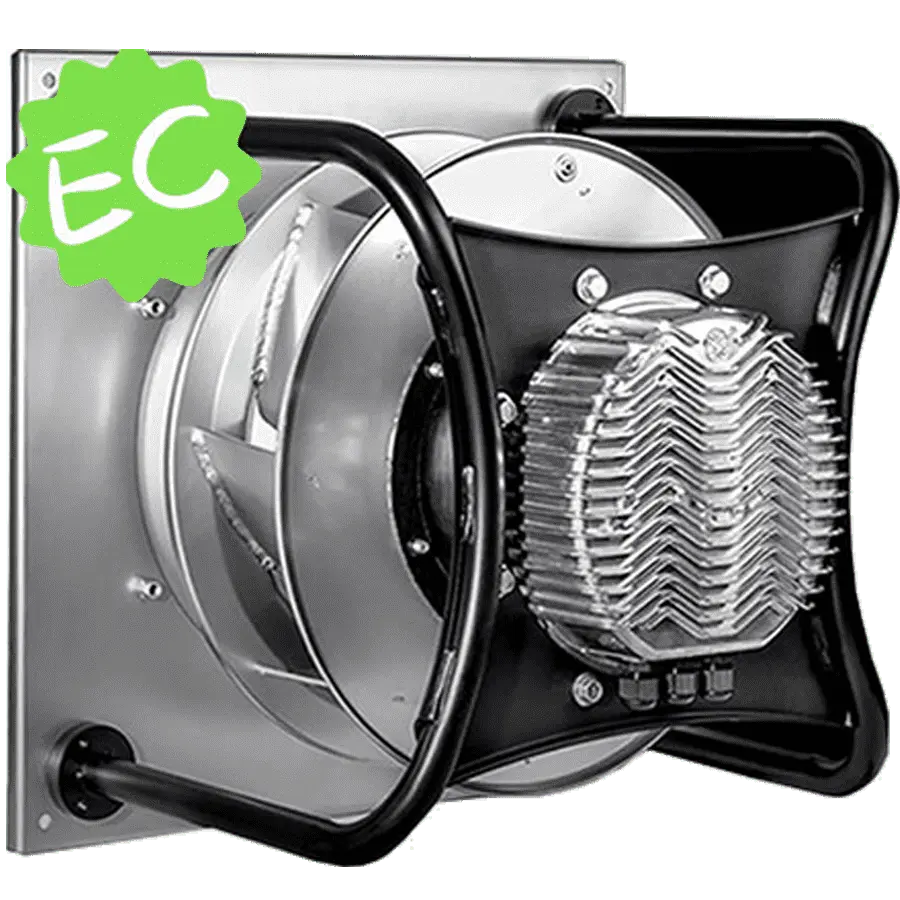AC forward bending centrifugal fans are widely used in various industrial and commercial applications to provide efficient and reliable air movement. These fans utilize a unique design that enables them to generate high airflow and pressure, making them suitable for demanding environments. In this article, we will explore how AC forward bending centrifugal fans work, highlighting their key components, operational principles, and the benefits they offer.
Overview of AC Forward Bending Centrifugal Fans
- Fan Design:AC forward bending centrifugal fans feature a cylindrical housing with an inlet and an outlet. The impeller, positioned inside the housing, consists of curved blades that direct the airflow in a forward direction as it passes through the impeller. This design allows for efficient air movement and pressure generation.
- Motor Type:These fans are powered by AC (alternating current) motors, which are commonly used in commercial and industrial applications. AC motors can provide reliable and consistent power to drive the impeller, ensuring steady airflow and performance.
How AC Forward Bending Centrifugal Fans Work
- Air Intake:The fan’s operation begins with the intake of ambient air through the inlet. The shape and design of the fan’s inlet facilitate the smooth entry of air into the housing.
- Impeller Rotation:As the AC motor powers the impeller, it begins to rotate at a high speed. The curved blades on the impeller create a centrifugal force, propelling the air outwards in a forward direction.
- Air Acceleration and Pressure Generation:The forward bending design of the impeller blades causes the incoming air to accelerate as it moves through the impeller. This acceleration results in an increase in air pressure, creating a higher pressure zone within the fan.
- Air Discharge:Once the air reaches the outlet of the fan, it is discharged in the forward direction. The high pressure generated by the impeller allows the fan to deliver airflow with substantial force, making it suitable for applications that require air movement against resistance.
Benefits of AC Forward Bending Centrifugal Fans
- High Airflow and Pressure
AC forward bending centrifugal fans are known for their ability to generate high airflow and pressure. The forward bending impeller design ensures efficient acceleration and pressure generation, making these fans ideal for applications that demand robust air movement, such as HVAC systems, industrial ventilation, and air pollution control. - Energy Efficiency
These fans are often designed with energy efficiency in mind. AC motors used in the fans are known for their high efficiency, resulting in reduced energy consumption. This makes AC forward bending centrifugal fans cost-effective and environmentally friendly. - Versatility and Adaptability
AC forward bending centrifugal fans can be customized to meet specific airflow and pressure requirements. They can be integrated into various systems and configurations, allowing for adaptability in diverse applications and environments. - Low Noise Operation
Many AC forward bending centrifugal fans are designed with noise reduction features. The impeller and housing are engineered to minimize noise levels, ensuring a quieter working environment in applications where noise control is important. - Durability and Reliability
These fans are built to withstand demanding conditions. The robust construction and high-quality materials used in their manufacturing ensure long service life and reliable performance, minimizing maintenance requirements and downtime.
What are some of the noise reduction features commonly found in AC forward bending centrifugal fans?
AC forward bending centrifugal fans often incorporate various noise reduction features to minimize noise levels during operation. Some commonly found noise reduction features include:
- Acoustic Insulation:The housing of the fan may be constructed using materials that have sound-absorbing properties, such as specialized insulation materials or dense foam. These materials help to absorb and dampen sound waves, reducing noise transmission from the fan.
- Vibration Dampening:Vibrations generated by the rotating components, such as the impeller and motor, can contribute to noise. To mitigate this, vibration dampening techniques are employed. This may involve using rubber or elastomeric mounts to isolate the motor and impeller from the housing, reducing the transfer of vibrations and minimizing noise.
- Aerodynamic Design:The design of the impeller and housing plays a crucial role in minimizing noise. By optimizing the aerodynamics of the fan, including the shape and curvature of the blades, the airflow can be streamlined to reduce turbulence and associated noise generation.
- Blade Design:The design of the impeller blades can impact noise levels. Forward bending centrifugal fans may incorporate specially designed blades that reduce noise by minimizing air turbulence and optimizing airflow efficiency. These blade designs help to reduce the noise generated as air passes through the impeller.
- Fan Speed Control:Controlling the speed of the fan can also contribute to noise reduction. Variable frequency drives (VFDs) or speed controllers can be utilized to adjust the fan’s speed based on the specific requirements of the application. By operating the fan at lower speeds when possible, the noise level can be reduced.
- Enclosure Design:Some AC forward bending centrifugal fans may feature enclosures or covers that further reduce noise transmission. These enclosures are designed to contain and dampen sound, preventing it from escaping into the surrounding environment.
It’s important to note that the specific noise reduction features incorporated in AC forward bending centrifugal fans can vary depending on the manufacturer and the intended application. The combination of these features helps to ensure quieter operation, making these fans suitable for applications where noise control is crucial, such as in HVAC systems, commercial buildings, and other noise-sensitive environments.
AC forward bending centrifugal fans are essential components in numerous industrial and commercial applications where high airflow and pressure are required. Their unique design and operational principles enable efficient air movement, making them suitable for demanding environments. With benefits such as high airflow and pressure, energy efficiency, versatility, ac forward curved centrifugal fan manufacturer low noise operation, durability, and reliability, AC forward bending centrifugal fans are a valuable solution for achieving efficient and reliable air circulation in a wide range of applications.
